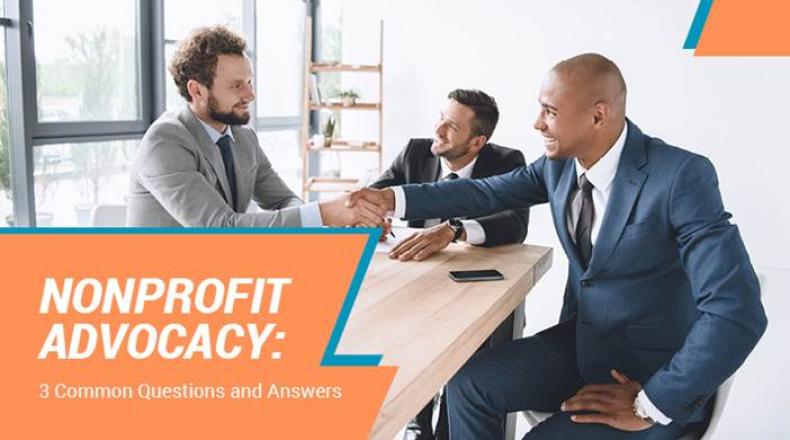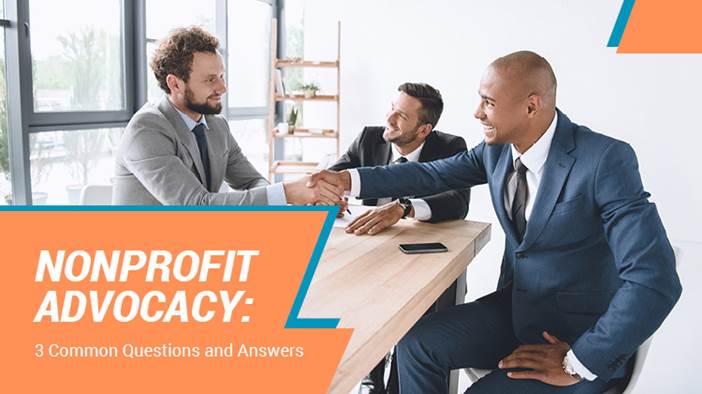Nonprofit Advocacy: 3 Common Questions and Answers

Nonprofit and philanthropic organizations can benefit significantly from incorporating advocacy into their strategies. It’s an inexpensive way for supporters to get involved, which is especially important given the economic downturn resulting from the COVID-19 pandemic. Plus, it allows you to influence legislation that has a direct impact on your mission.
Advocacy, however, is a general term. Many nonprofits run into questions about what it is, how it works, and how they can use the advocacy tools in their arsenal to create the most effective campaign possible.
We’ve compiled three common questions that many organizations have about advocacy. We’ll answer these questions in-depth so that you’re prepared to make the most out of your campaign. These questions include:
- How is advocacy different from lobbying?
- What can I do to make my representative care about my mission?
- Who are my advocates, and how can I acquire more?
Ready to get these questions answered? Let’s dive deeper.
1. How is advocacy different from lobbying?
When your nonprofit advocates for your cause, you’re informing your legislators about your mission. You’re informing them about a cause that is near and dear to you and their constituents. This way, when something comes across their plate that is relevant to this cause, they know that many of their constituents care, and they’ll act in the best interest for the cause.
Meanwhile, lobbying involves urging your representatives to take action on a specific piece of legislation in a direction that will best impact your mission. While nonprofit organizations are allowed to lobby in many circumstances, there are stricter rules for 501(c)(3) organizations. For instance, an organization can allocate only a certain amount of its budget to lobbying activities.
Both advocacy and lobbying require your organization and supporters to reach out to their representatives. That means that both approaches will use similar software. Just be sure to explain to supporters and team members how you’ll be employing that software for your campaign.
2. What can I do to make my representative care about my mission?
Advocacy can be intimidating. Although many legislatures already know exactly what it is that your organization will talk about (after all, they hear many advocates and lobbyists as a regular part of their jobs), you need to find a way to engage them.
The best way to convince them to care? Use storytelling strategies.
Just as effective fundraisers use storytelling to convince people to give to your mission, stories can also show the importance of your mission and express how it’s impacting the community. It’s how you can make sure your voice is heard amidst the clutter of politics.
As you use your advocacy software to encourage supporters to reach out to their legislators, be sure to include a specific story in the campaign that will capture representatives’ hearts. You should not only include a story as an organization but also ask your supporters to engage in the storytelling process by sharing their connection to your cause as they reach out as well.
Recognize that legislators place a higher value on an email than a tweet and a higher value on a phone call than an email. Provide your supporters with suggested language and the correct links, emails, and phone numbers for their specific legislators. You may also want to consider advocacy campaigns focused on corporate executives or others outside of local, state or federal legislatures.
To see this in action, check out other campaigns such as those featured in Salsa’s nonprofit advocacy examples. By viewing other campaigns, your organization can better understand how to include storytelling practices as a part of your petitions, click-to-call campaigns, advocacy events and more.
3. Who are my advocates and how can I acquire more?
Your nonprofit’s advocates are supporters who participate in the outreach campaigns you conduct to touch the hearts of your nonprofit’s legislators. While retaining advocates from campaign to campaign is the best way to ensure you have the support you need, it’s also necessary to reach new audiences and expand each initiative’s impact.
To acquire new advocates, we recommend that your nonprofit first reach out to your other supporters. These are the individuals who have contributed to your mission (donations, volunteering, etc.), but have not yet participated in an advocacy campaign. For instance, ask your donors and volunteers to participate. They’ve already shown an interest in your mission and will likely be happy to help in more than one capacity.
Be sure to give these individuals an actionable next step when you reach out. Petitions are generally a great way to encourage new advocates to get involved because it requires the smallest investment of time and energy.
If you’re looking to get started with an advocacy campaign, we recommend that your organization consider multi-faceted advocacy software that integrates with your marketing software and CRM solutions (like this one). This way, you can effectively reach your intended audience to grow your campaign while capturing all relevant advocacy information for the future.
 Gerard Tonti is the senior creative developer at Salsa Labs, the premier fundraising software company for growth-focused nonprofits. Gerard's marketing focus on content creation, conversion optimization, and modern marketing technology helps him coach nonprofit development teams on digital fundraising best practices.
Gerard Tonti is the senior creative developer at Salsa Labs, the premier fundraising software company for growth-focused nonprofits. Gerard's marketing focus on content creation, conversion optimization, and modern marketing technology helps him coach nonprofit development teams on digital fundraising best practices.